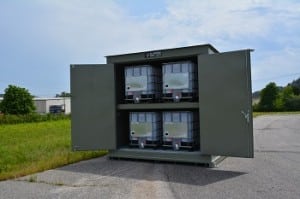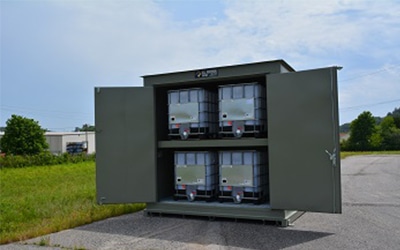
A tote is a common name for an
Intermediate Bulk Container (IBC) used to store various chemicals. They have grown in popularity due to their improved space efficiency compared to
drums and their re-usability through cleaning and recycling. Totes often contain flammable liquids and as such are subject to stringent regulations regarding storage and handling.
Climate Control for Flammable Liquids
Flammable liquids are defined by the National Fire Protection Association (NFPA) in their standard
NFPA 30 as Class I liquids, with a Flash-point below 100 degrees Fahrenheit.
Class I flammable liquids are broken down into three sub-categories:
- Class IA: Flashpoint < 73 degF and Boiling Point < 100 degrees Farenheit
- Class IB: Flashpoint < 73 degF and Boiling Point > 100 degrees Farenheit
- Class IC: Flashpoint >= 73 degF and < 100 degrees Farenheit
Flash-point is a measure of the minimum temperature at which enough vapor is given off from the liquid to ignite. Boiling Point is a measure of the temperature at which the liquid changes into a gaseous state. These characteristics of flammable liquids highlight the risks associated with their handling and storage and the care which should be taken to prevent fires and explosions.
Standards Related to Flammable Chemical Storage
Manufacturing facilities which use flammable chemicals stored in totes as raw materials face the challenge of keeping to NFPA and OSHA standards for safety while maintaining an efficient workflow. NFPA 30 is a code that describes the storage and handling of flammable and combustible liquids. This code forms the basis of other standards like the OSHA 1910. Key elements that are detailed in NFPA 30 include the following:
- Maximum allowable size of container for different materials (e.g. Glass, metal, plastic)
- The separation distance required between outside storage areas and occupied buildings
- Security and fire protection requirements of outside storage areas
- Specifications for storage cabinets housing small amounts of liquids inside a building
- Maximum volumes of flammable liquids for storage in internal storage cabinets
- Specifications for flammable liquid storage rooms
- Specifications for hazardous chemicals lockers
Climate Controlled Tote Lockers by U.S. Chemical Storage
The US Chemical Tote Lockers fall into the category of
hazardous chemicals lockers and are therefore covered by NFPA 30. The design of the lockers with their specific fire protection elements enable them to be conveniently placed close to (or even inside an occupied building). Hazardous chemical lockers are constructed of fire resistant material, have automated fire protection and alarms and are designed to prevent spills from spreading.
Storing Multiple Totes in a Single Storage Locker
Chemicals can be categorized in groups according to compatibility. It is important to segregate totes of incompatible materials from one another in storage lockers. This is due to the fact that certain chemicals when mixed together can create a worse hazard than each one on its own. Different classes of flammable liquids can be separated from each other, or bases and acids can be separated from each other. There are different methods for categorizing chemical substances and the appropriate method must be selected for the specific application, while ensuring compliance with regulatory requirements.
Contact Us
Contact
U.S. Chemical Storage to learn more about tote storage lockers or to receive a complimentary quote. Our professional consultants can advise you on the best solution for your application as well as the regulatory requirements that are relevant to your industry.
List of standards for flammable liquid storage
29 CFR OSHA 1910.106 – Flammable Liquids
NFPA 30 – Flammable and Combustible Liquids Code
References
Workplace Safety. Flammable and Combustible Liquids Storage and Handling
Industrial Tote Services.
Totes vs Drums

 A tote is a common name for an Intermediate Bulk Container (IBC) used to store various chemicals. They have grown in popularity due to their improved space efficiency compared to drums and their re-usability through cleaning and recycling. Totes often contain flammable liquids and as such are subject to stringent regulations regarding storage and handling.
A tote is a common name for an Intermediate Bulk Container (IBC) used to store various chemicals. They have grown in popularity due to their improved space efficiency compared to drums and their re-usability through cleaning and recycling. Totes often contain flammable liquids and as such are subject to stringent regulations regarding storage and handling.
